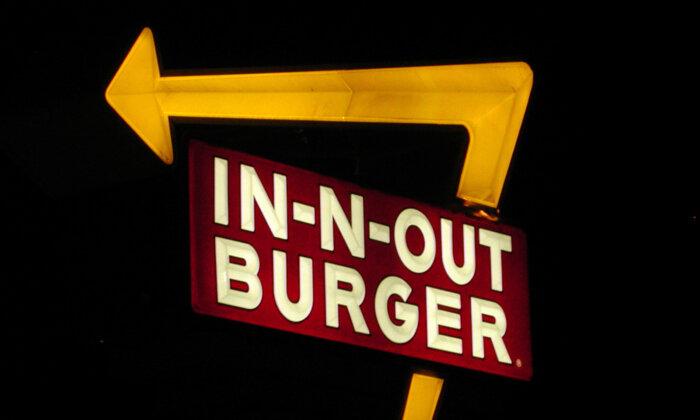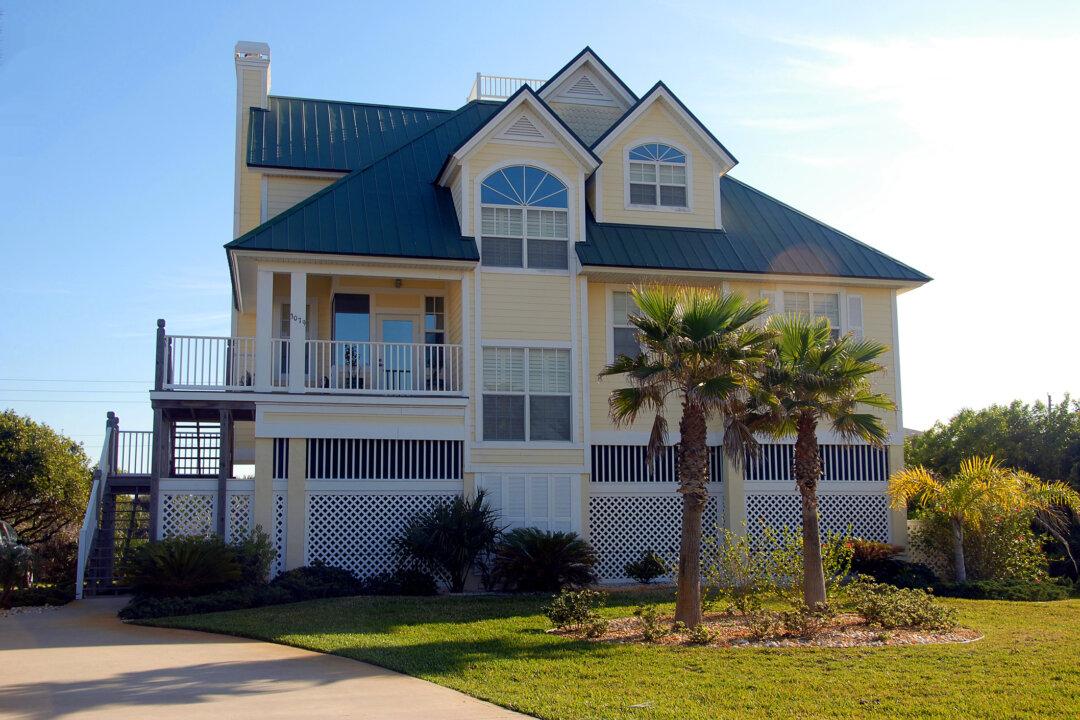LOS ANGELES—The year was 1948. World War II was in the rearview mirror and in Los Angeles, drive-in restaurants were in full swing.
Those food stands that first began sprouting up more than a decade earlier had evolved. In a city where the number of drive-ins was said to equal the number of cars, they were destinations with bright neon signs, whimsical architecture, expansive parking lots and costumed carhops—serving patrons using specially made trays attached to their car windows.
But when Harry and Esther Snyder opened the first In-N-Out Burger, they had just a spit of land on Francisquito and Garvey avenues in Baldwin Park. They had even less money to build a burger palace. But over time, burger by burger, they changed history.
This month marks In-N-Out Burger’s 75th anniversary. Though its first customers were locals drawn from its sleepy Los Angeles suburb, for generations In-N-Out has captivated everyone from movie stars to truck drivers to Michelin-starred chefs who go weak at the knees at the thought of a Double-Double.
Harry was an amateur electronics enthusiast, and he devised a two-way speakerphone system. Customers drove in and placed their order into a speaker connected to the kitchen, then drove out with their burgers. (They were given sheets of butcher paper to put on their laps to avoid messes while eating in their cars.)
At first, many people were confused about how to order, and for a time the Snyders sent their sons Guy and Rich to instruct customers. That two-way radio gave the chain its name: In-N-Out Burger. It was also the beginning of the drive-thru.
From its start, In-N-Out mirrored the rise of postwar California’s outsized cultural influence on the rest of the country, with its association to cars, celebrities and food. It is fair to say that the iconoclastic family-owned In-N-Out Burger—now run by third-generation heiress Lynsi Snyder—is not just a burger joint or even a fast-food chain. It has become an unmistakable part of Southern California mythology.
When I wrote the book “In-N-Out Burger: A Behind-the-Counter Look at the Fast-Food Chain That Breaks all the Rules” in 2009, the chain was hugely popular with a fervid customer base, bordering on obsessed, and yet little was known about its origins or the family behind it. The elusive Snyders maintained a low profile. They rarely did press. For the most part, the company followed founder Harry Snyder’s belief that it was best to let their burgers do the talking.
I grew up in Southern California, eating Animal Style cheeseburgers. The process of understanding the story behind those burgers wasn’t easy. I interviewed more than 100 people, including the broader members of the Snyder family and company associates. However, its key players declined to cooperate.
Not long before my book was published, I got a call from Lynsi Snyder’s publicist. She apparently had gotten ahold of an early copy and wanted a sit-down. I agreed. However, that meeting never happened, due to “scheduling,” I was told.
While I didn’t set out to write a hagiography, I learned that despite operating counter to every conventional tenet of American business, In-N-Out has remained faithful to its founding mission and is enormously profitable. It is a classic family business—with a very complicated family behind it.
In those early days in the 1940s, Harry made the burgers himself and Esther kept the books from her kitchen table, across the street from the first stand.
Harry was exacting. He examined the potatoes for the fries as well as the tomatoes, onions and lettuce straight off the freight train. Every chuck was made under his supervision. At one point, he bought a cattle ranch, thinking he could control the entire process from cow to burger patty. He had a simple management philosophy: “Quality, Cleanliness and Service.”
To this day all burgers are custom-made, nothing is frozen, the restaurants are sparkling clean, and its employees have long been known to be some of the highest paid in the fast-food industry. Although its fries remain a source of controversy, sparking fierce online debate, the chain has stuck to its style, which results in a relatively softer texture than many rivals’ crispier fries.
That single store in Baldwin Park has evolved into nearly 400 locations in seven states (California, Utah, Arizona, Nevada, Texas, Oregon, Colorado). A store in Idaho is under construction; this year the company announced plans to expand further east, to Tennessee in 2026.

In the decades since store No. 1 opened, In-N-Out has become a cultural touchstone. A Hong King real estate magnate once told me it was his first stop after arriving at LAX—he wasn’t the only one. Customers, fans really, have told me of the lengths they’ve gone to eat a Double-Double, from sending the burgers by plane to driving through the night.
The French Laundry’s Thomas Keller described to me the pilgrimage he makes when in Los Angeles with the friend who first introduced him to In-N-Out—accompanied by a good bottle of wine. The French-born, New York-based Michelin-starred chef Daniel Boulud called its burger “perfection.” In her purse, Julia Child kept a map of all In-N-Out locations between her house in Santa Barbara and Los Angeles.
“Actually, In-N-Out plays a big role in my life,” singer Katy Perry once told TV host Jimmy Kimmel, explaining the part it played in her meeting her fiancé Orlando Bloom, when they bonded over the burgers after he stole hers at the Golden Globes.
Staying the Same
Indeed, the menu remains largely the same as it was when Truman was president, and the Snyder family has clung stubbornly to Harry’s corporate philosophy. While the fast-food industry it helped launch morphed into a network of global conglomerates, the Snyders have rebuffed all calls to franchise, go public or be acquired.
The secret to the company’s success is perhaps eschewing all mantras to constantly innovate.
In-N-Out Burger began the same year and 45 minutes away from McDonald’s, but it has charted a very different path. It rarely advertises beyond billboards and radio jingles; it has never done movie tie-ins or followed fads. In the 1980s, the family controversially put its private beliefs on display, printing Bible passages on burger wrappers and French fry boats. In 2021, the chain refused to comply with a local law requiring restaurants to ask customers for proof of COVID-19 vaccination, calling the mandate “unreasonable” and “invasive.” Health officials briefly shut down a San Francisco location in response.
For all the chain’s success, however, the family behind it has been rocked by tragedies and challenges.
In 1976, after Harry Snyder died, his son Rich, then 24, took over. He grew the chain from 13 stores to 93. It was Rich who professionalized management, launched In-N-Out University (where managers are trained) and established a path for the chain to grow without cutting corners or compromising its founding principles.
He died at age 41 in 1993 alongside another executive when the private plane they chartered to scout new locations crashed near a crowded Santa Ana mall. It happened just before he was to sign papers to take control of the company, removing his troubled older brother, Guy Snyder.
After Rich’s death, Guy became chairman and his mother, Esther, stepped in as president. Six years later, Guy died of an accidental overdose following a long struggle with drug abuse and various health problems.
In January 2006, the company was rocked by a bitter, soap opera-like lawsuit that threatened to expose internal tensions. Longtime employee Richard Boyd, a board member and co-trustee of the privately held company’s stock, accused Guy’s 23-year-old daughter, Lynsi Snyder, Harry and Esther’s granddaughter and only heir, and others of trying to mastermind a coup by ousting Esther Snyder and fast-tracking Lynsi’s takeover of the company. Boyd also claimed that he was wrongfully terminated.
The company denied Boyd’s allegations. The suit was settled five months later.
In 2010, Lynsi Snyder became In-N-Out’s president. One of America’s youngest billionaires, she has largely followed the path set down by her grandparents. She has made a few calculated forays in the public eye; she’s talked about her struggle with addiction, her marriages and divorces and even kidnapping attempts. In 2013, she founded the Army of Love, a Christian ministry that she runs with her fourth husband. This month, she is set to release a historical memoir of sorts about the family business.
She’s also hosting a party at the Pomona Raceway to celebrate the chain’s milestone year. As Lynsi Snyder leads In-N-Out’s charge into the future, she has begun to open up in recent years but generally on her own terms, that is to say, under specific circumstances.
Next time someone chomps into a Double-Double with abandon, they can be certain that, for the most part, In-N-Out will continue to do what it has done for the last 75 years: Let the burgers speak for themselves.

Los Angeles Times staff writer Stacy Perman is the author of the bestselling “In-N-Out Burger: A Behind-The-Counter Look at the Fast-Food Chain That Breaks All The Rules.”








